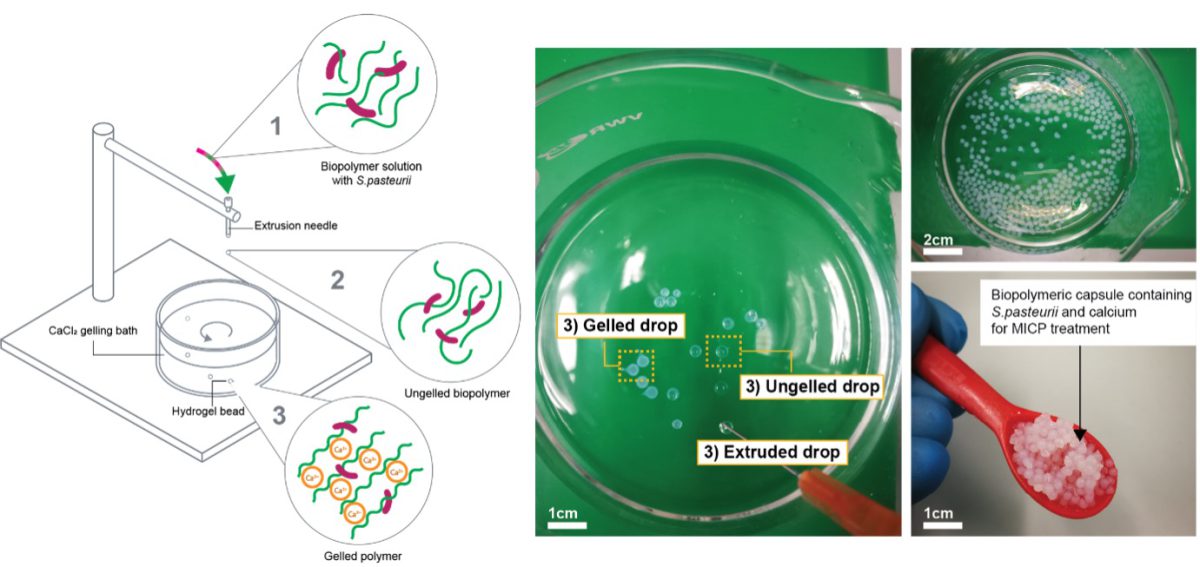EPFL scientists have developed a new approach to stabilizing clay soils. The method involves using a battery-like system to apply electric current to carbonate and calcium ions in order to promote soil consolidation. Their findings were published yesterday in Scientific Reports.
According to figures released by the UN yesterday, natural disasters have killed more than 1.2 million people since 2000 and cost nearly $ 3 trillion.These pressing threats bring into sharp focus the need for new answers to the problem of soil stabilization. Scientists at EPFL’s Laboratory of Soil Mechanics (LMS) have developed a number of sustainable solutions, including one that uses enzyme metabolism. Although these methods work for a wide range of soil types, they are considerably less effective when it comes to clay soils. In a paper published yesterday in Scientific Reports, the team demonstrates how chemical reactions can be enhanced by using a battery-like system to apply electric current.
A new type of biocement – produced in situ and at ambient temperature – has recently been put forth as a promising method for stabilizing various soil types. The method harnesses bacterial metabolism to produce calcite crystals that durably bond soil particles together. This biogeochemical process is energy-efficient and cost-effective, and could be rolled out quickly in the coming years. But since the ground needs to be impregnated for the method to work, it is less suited to low-permeability clay soils. Now, the LMS team has developed and successfully tested a viable alternative, which involves applying electric current using sunken electrodes. “Our findings show that this geoelectrochemical system does indeed influence key stages of the calcification process, especially the formation and growth of the crystals that bind the soil together and enhance its behavior,” says Dimitrios Terzis, a scientist at LMS and one of the co-authors of the paper.
The biocement is formed by introducing chemical species into the soil. These include dissolved carbonate and calcium ions, which carry opposite charges. Sunken anodes and cathodes are used to create an electric field, much in the same way as a giant battery. The current forces the ions to move across the low-permeability medium, where they intersect, mix together and eventually interact with soil particles. The result is the growth of carbonate minerals, which act as links or “bridges” that enhance the mechanical performance and resistance of soils.
Technology transfer grant
The paper, which sets out the team’s findings from observing and measuring the quality of these mineral bridges, paves the way for future developments in the field. Further tests, at different scales, are needed before the technology can be applied in the real world. The research was carried out under a 2018–2023 European Research Council (ERC) Advanced grant awarded to Prof. Lyesse Laloui, who heads the LMS and is a co-author of the paper. The project has three verticals, targeting the understanding of the fundamental mechanisms that occur at the soil-particle scale (micro-scale), the advanced characterization of mechanical behaviors at laboratory scale, and the large-scale development and demonstration of innovative systems in natural environments. In July 2020, the same research team obtained an additional ERC Proof of Concept grant to accelerate technology transfer to industrial applications.
In the past, soils were treated solely as a mix of solid earth, air and water. According to the co-authros, this research highlights how cross-disciplinary approaches i.e., drawing on concepts from biology and electro-chemistry and incorporating advances and mechanisms from other scientific fields can open exciting new paths and yield significant benefits.
References
[1] https://www.nature.com/articles/s41598-020-73926-z
[2] https://ec.europa.eu/jrc/en/news/critical-infrastructure-be-hard-hit-climate-hazards
[3] https://actu.epfl.ch/news/professor-laloui-awarded-a-prestigious-erc-advance/
[4] https://biogeos.epfl.ch/news/lyesse-laloui-awarded-a-prestigious-erc-proof-of-concept-grant/
Source: EPFL homepage


